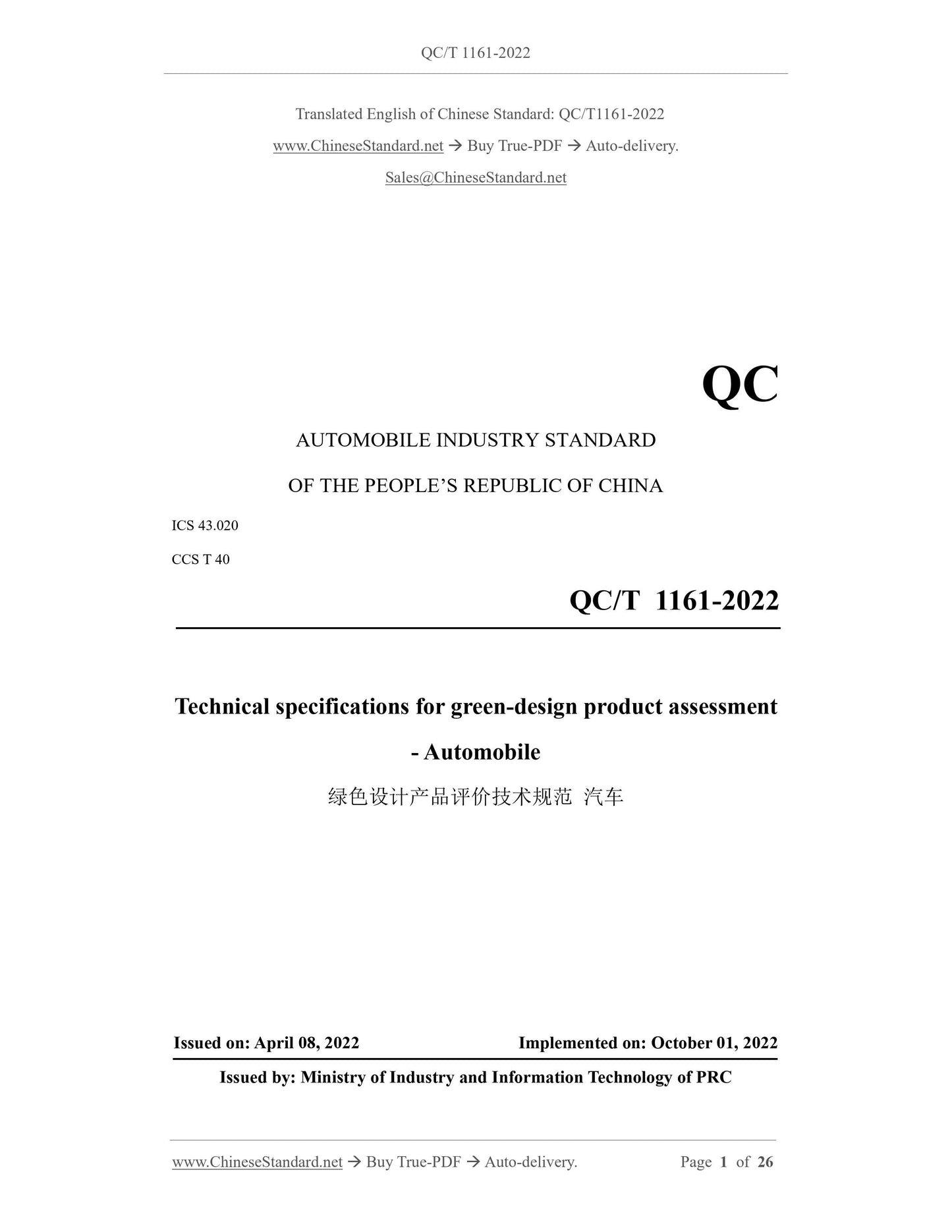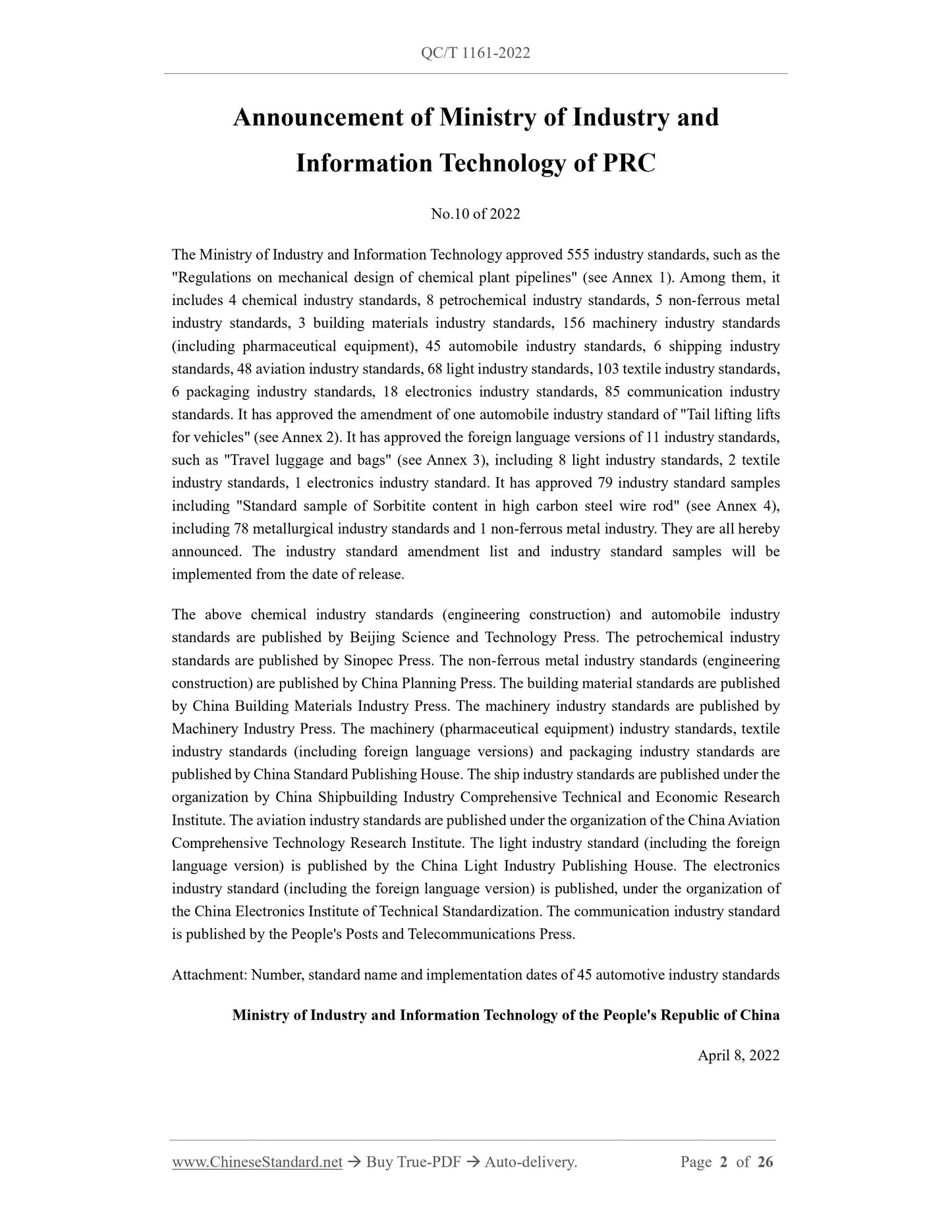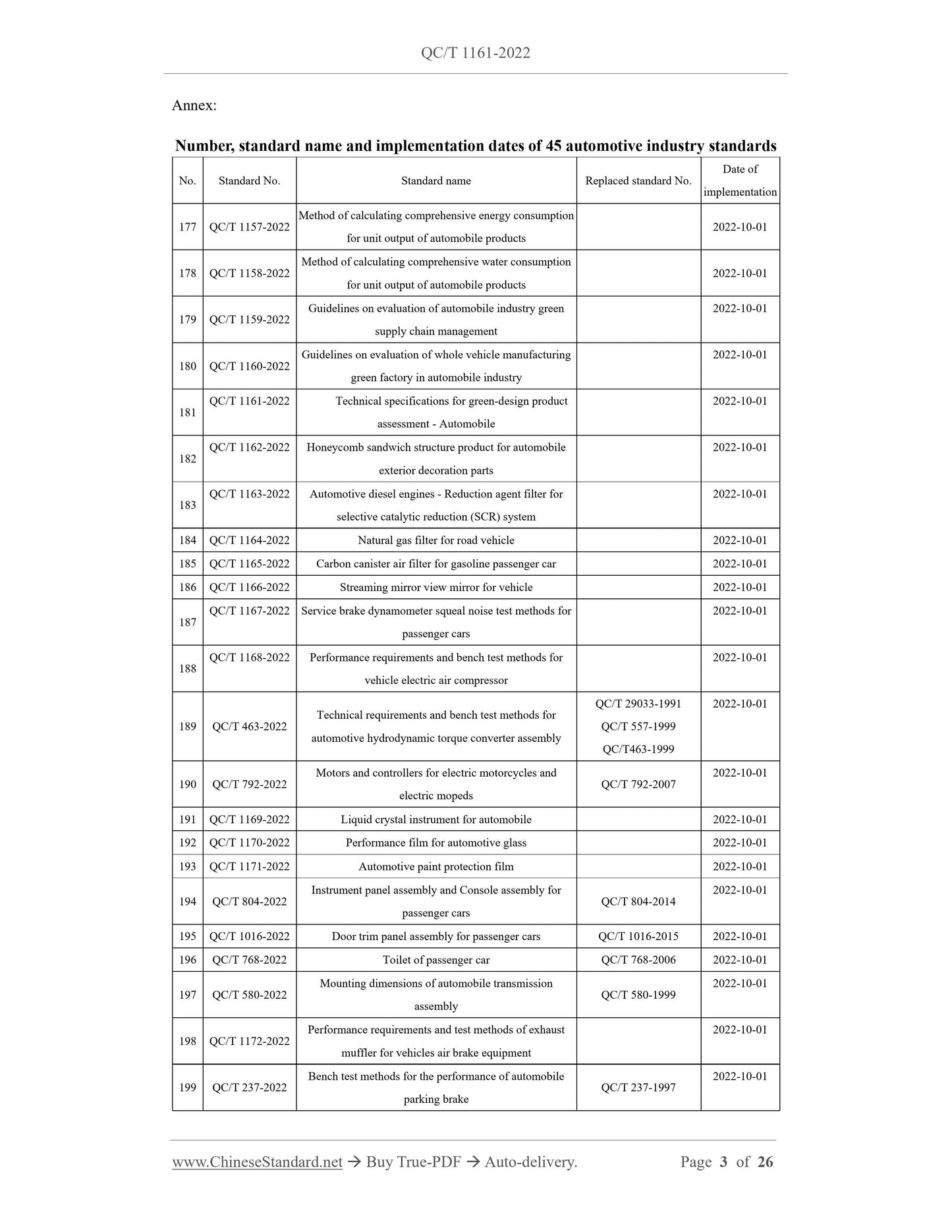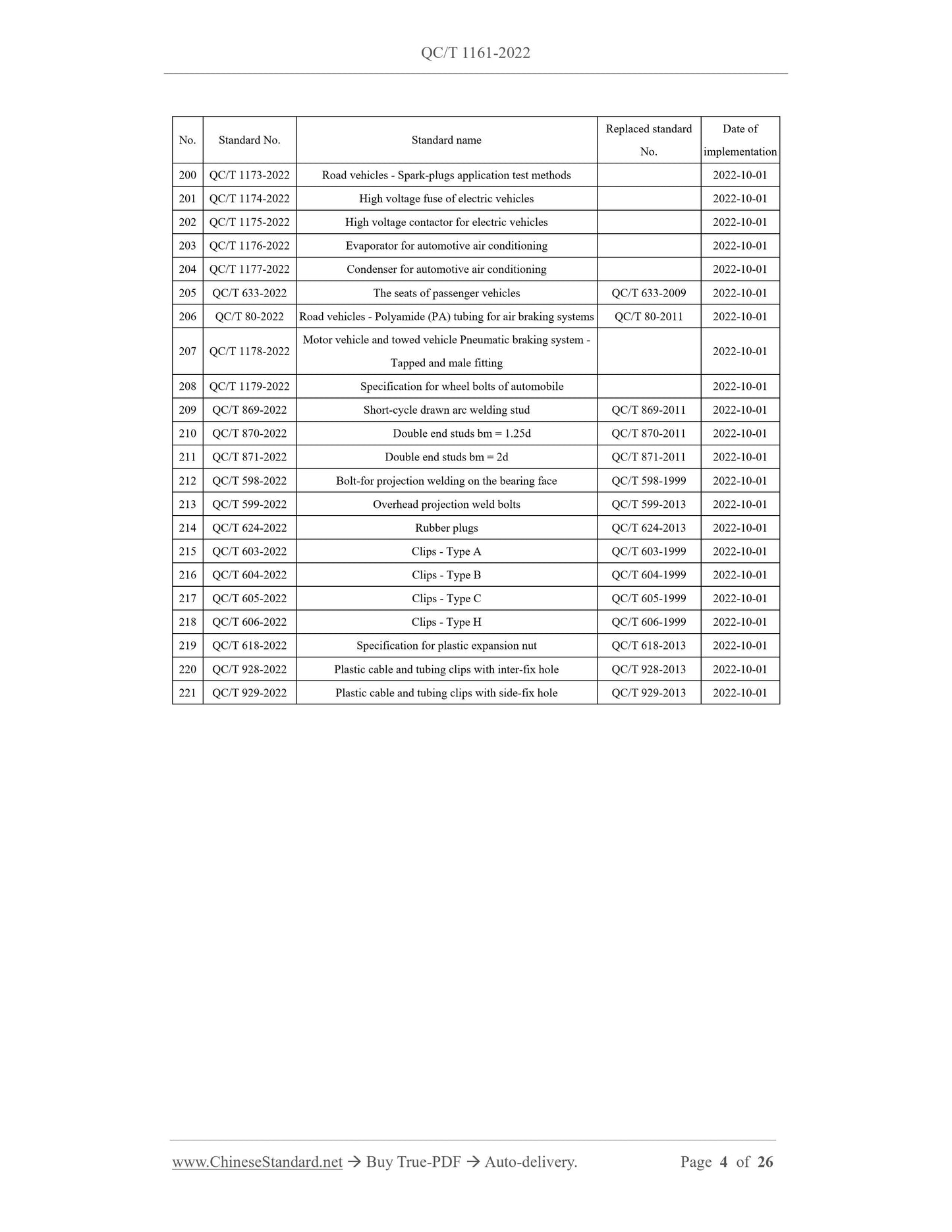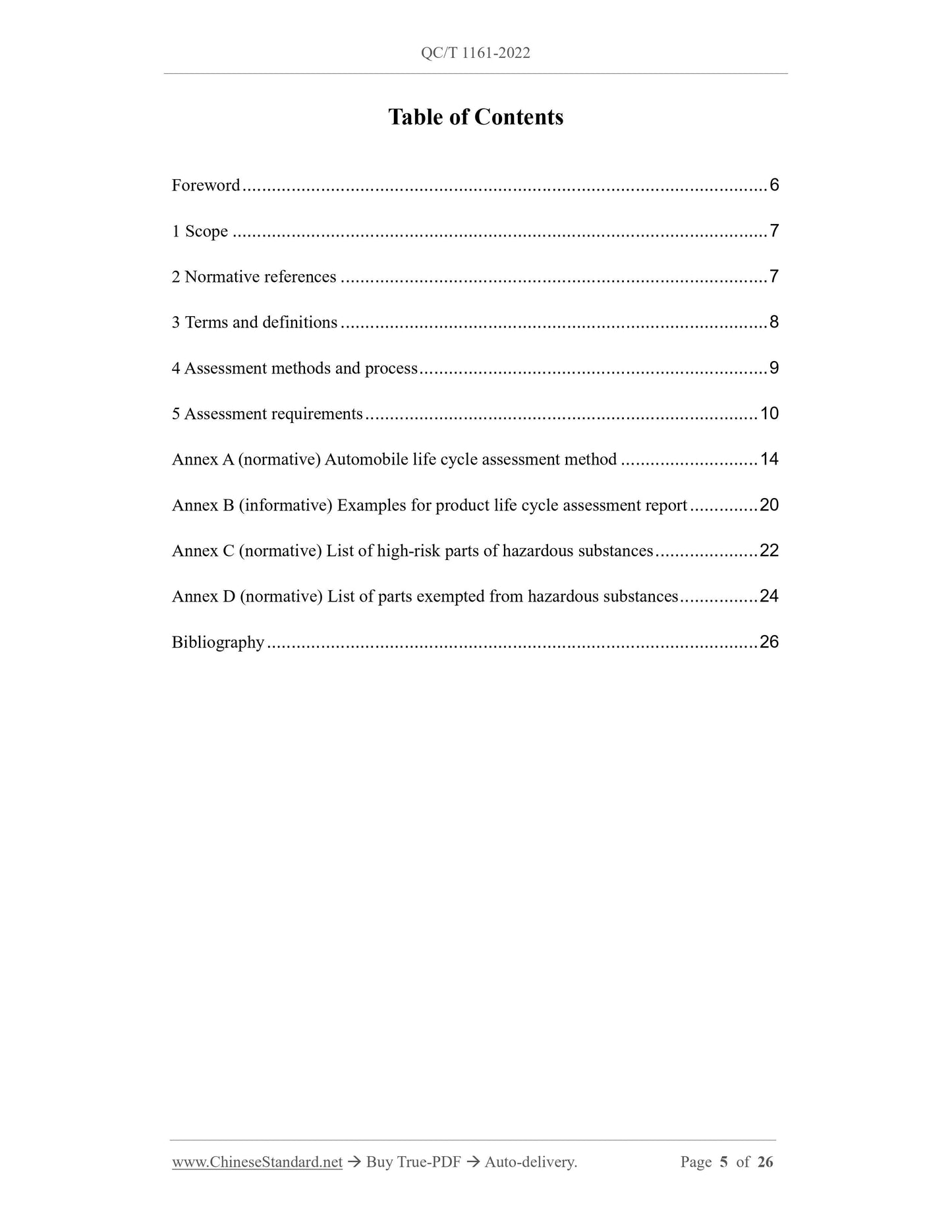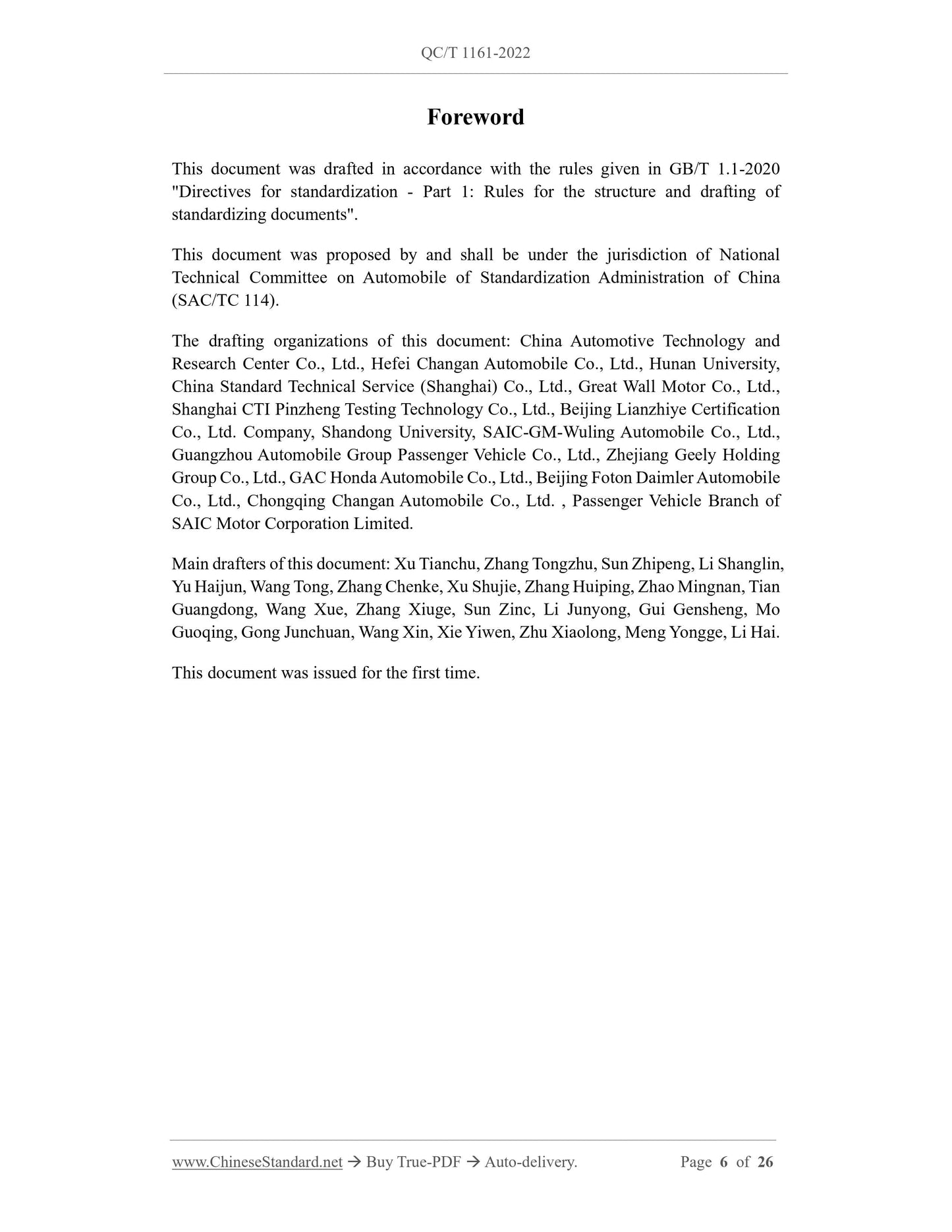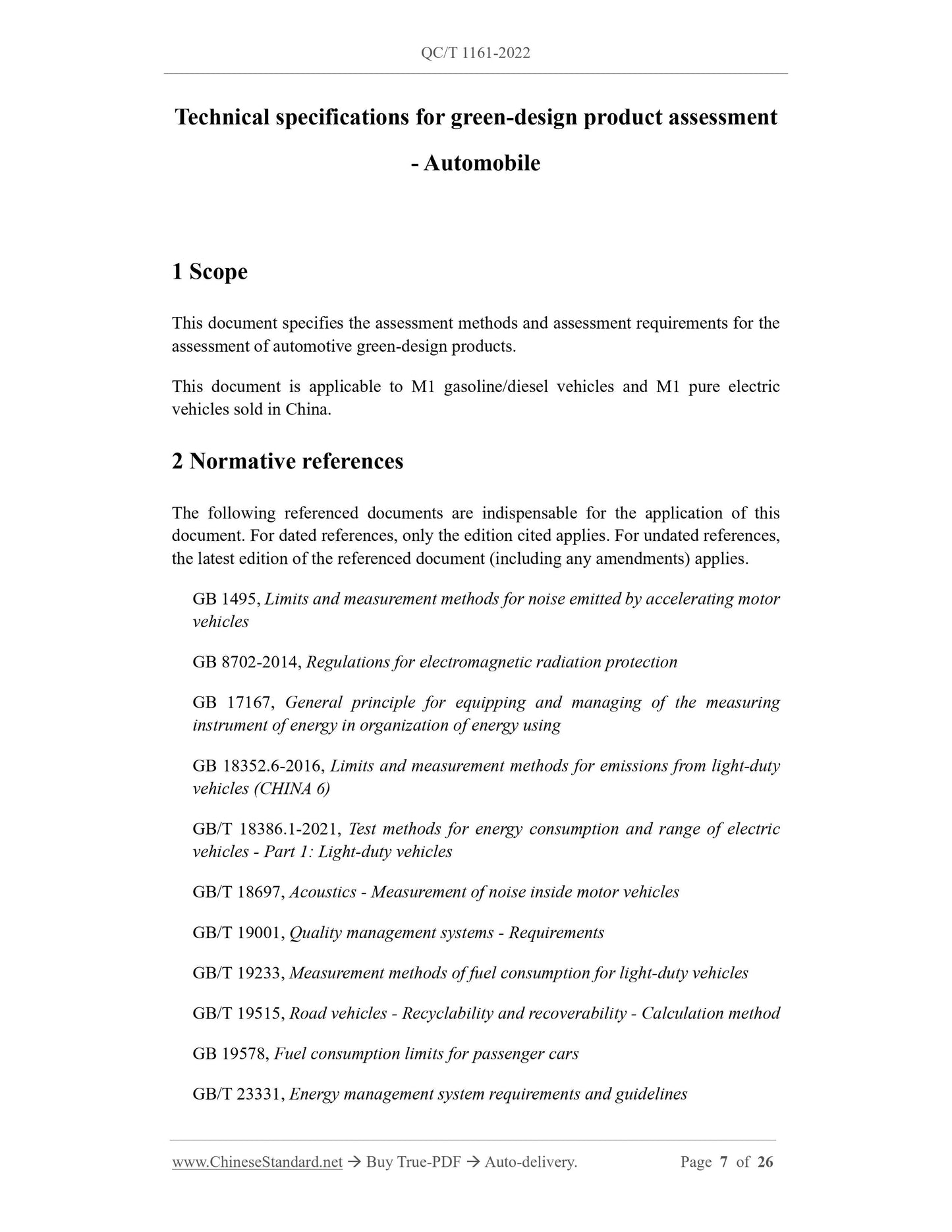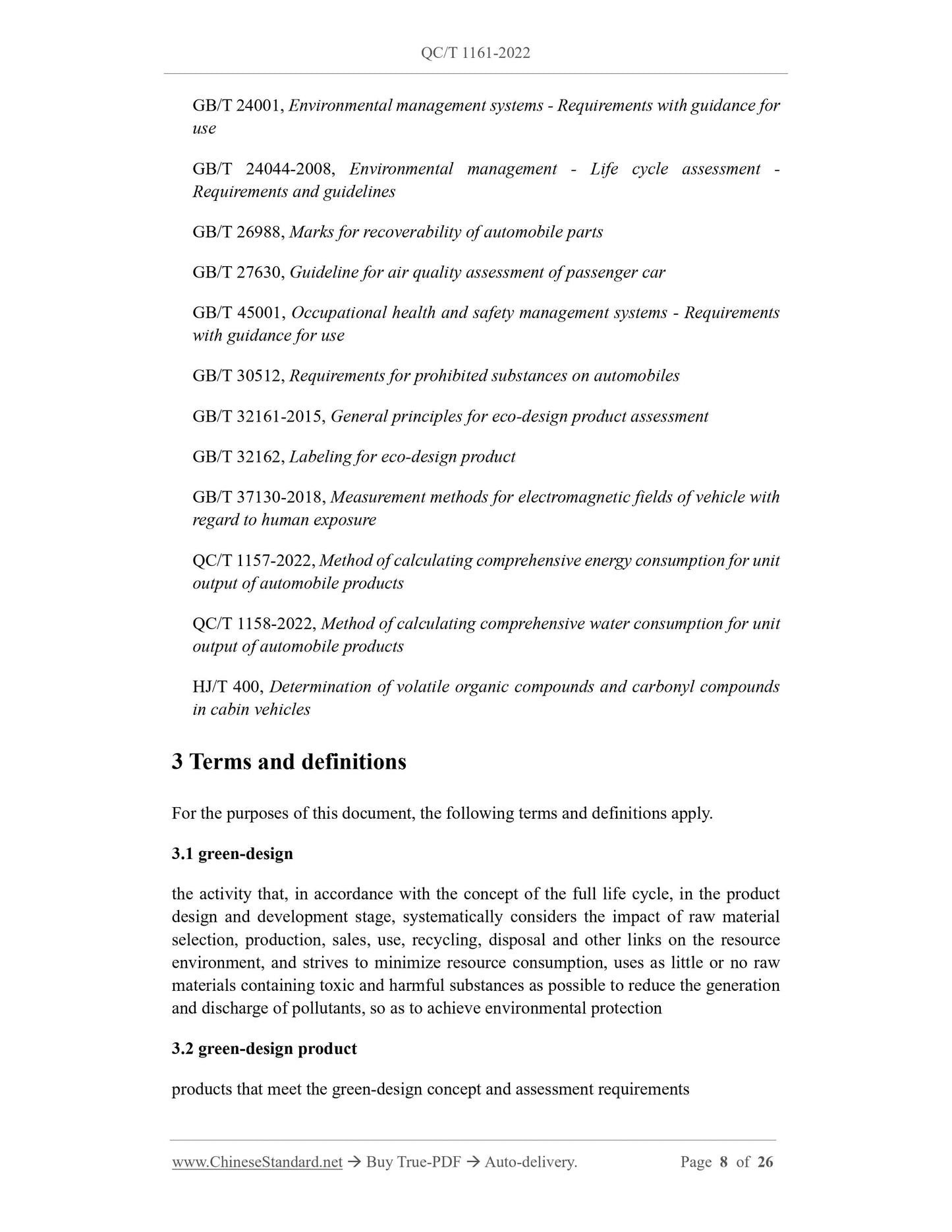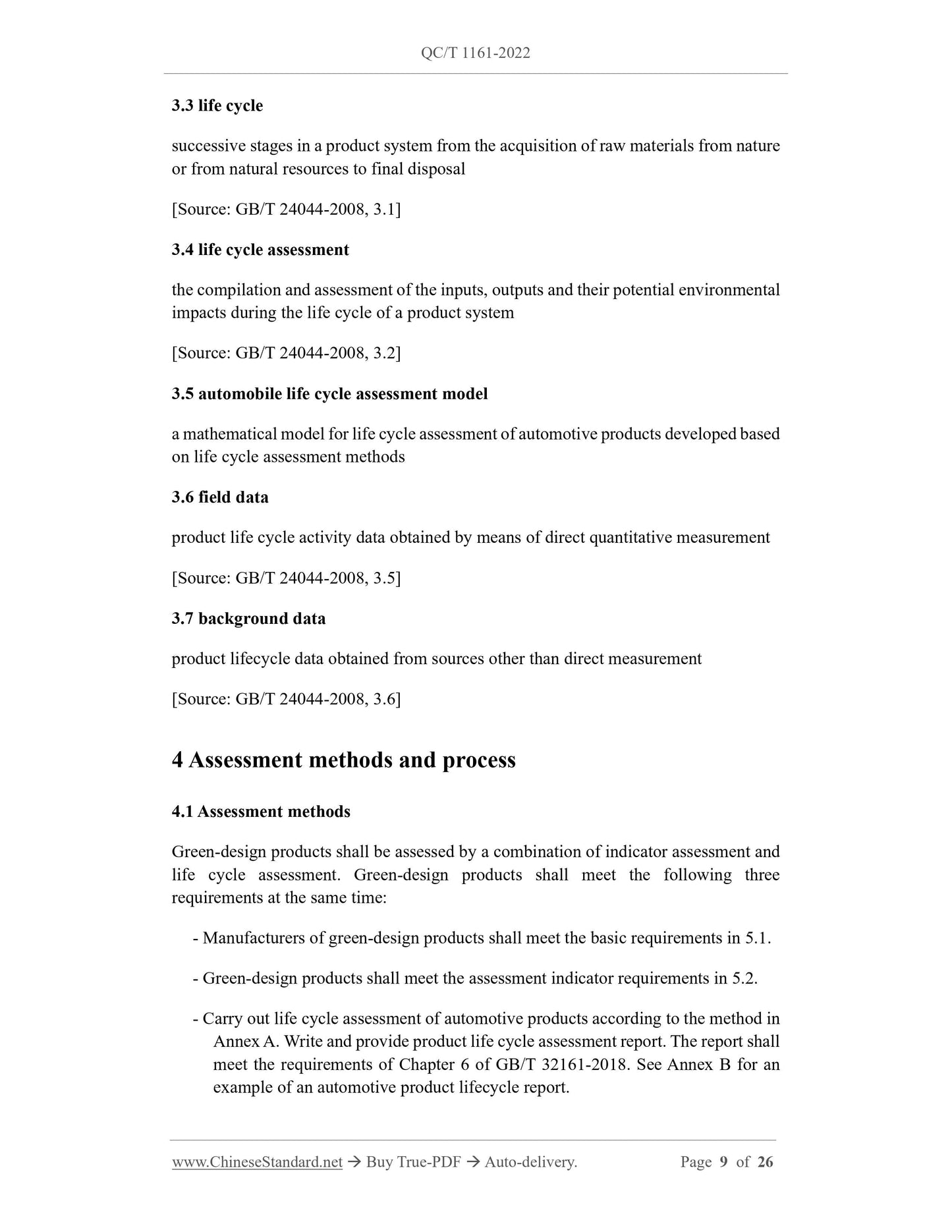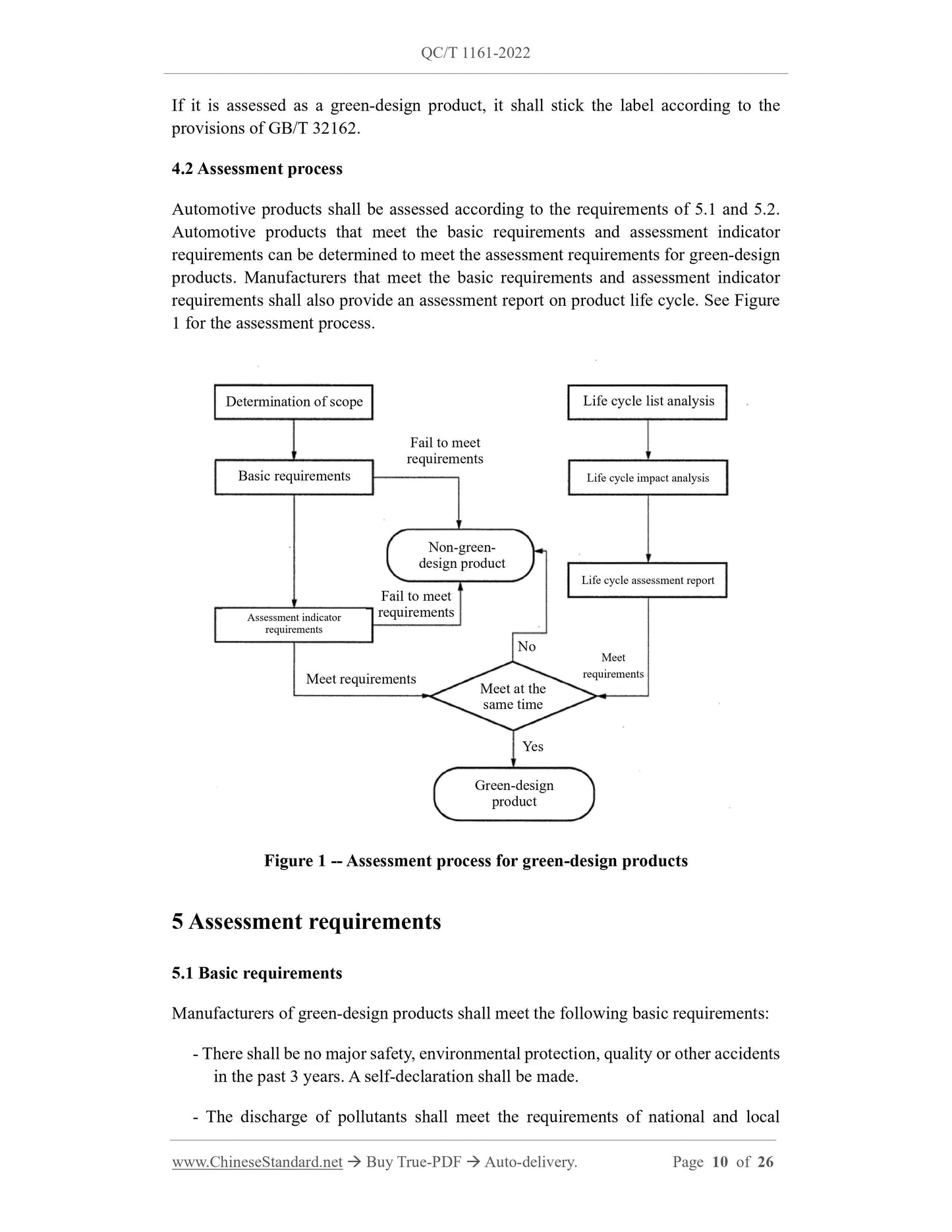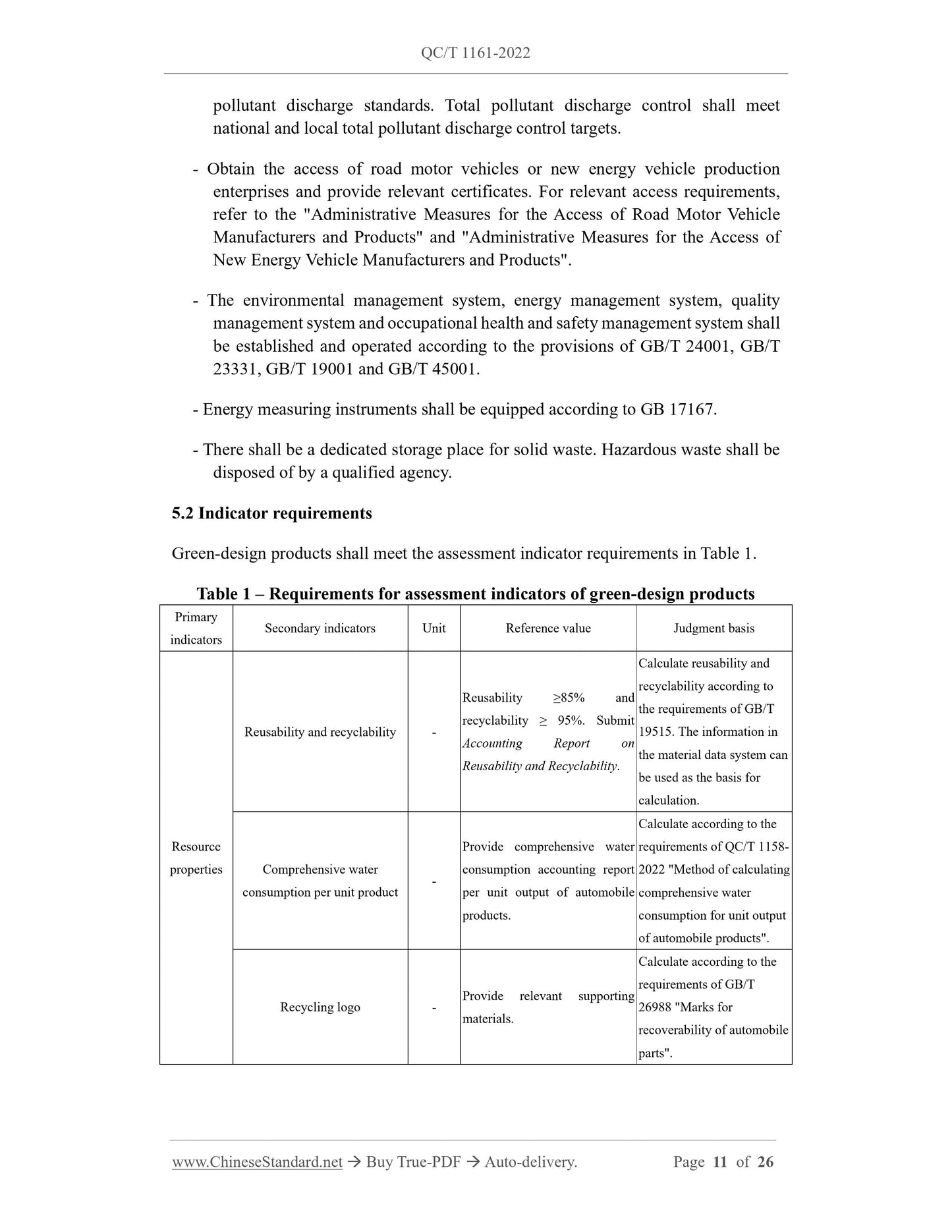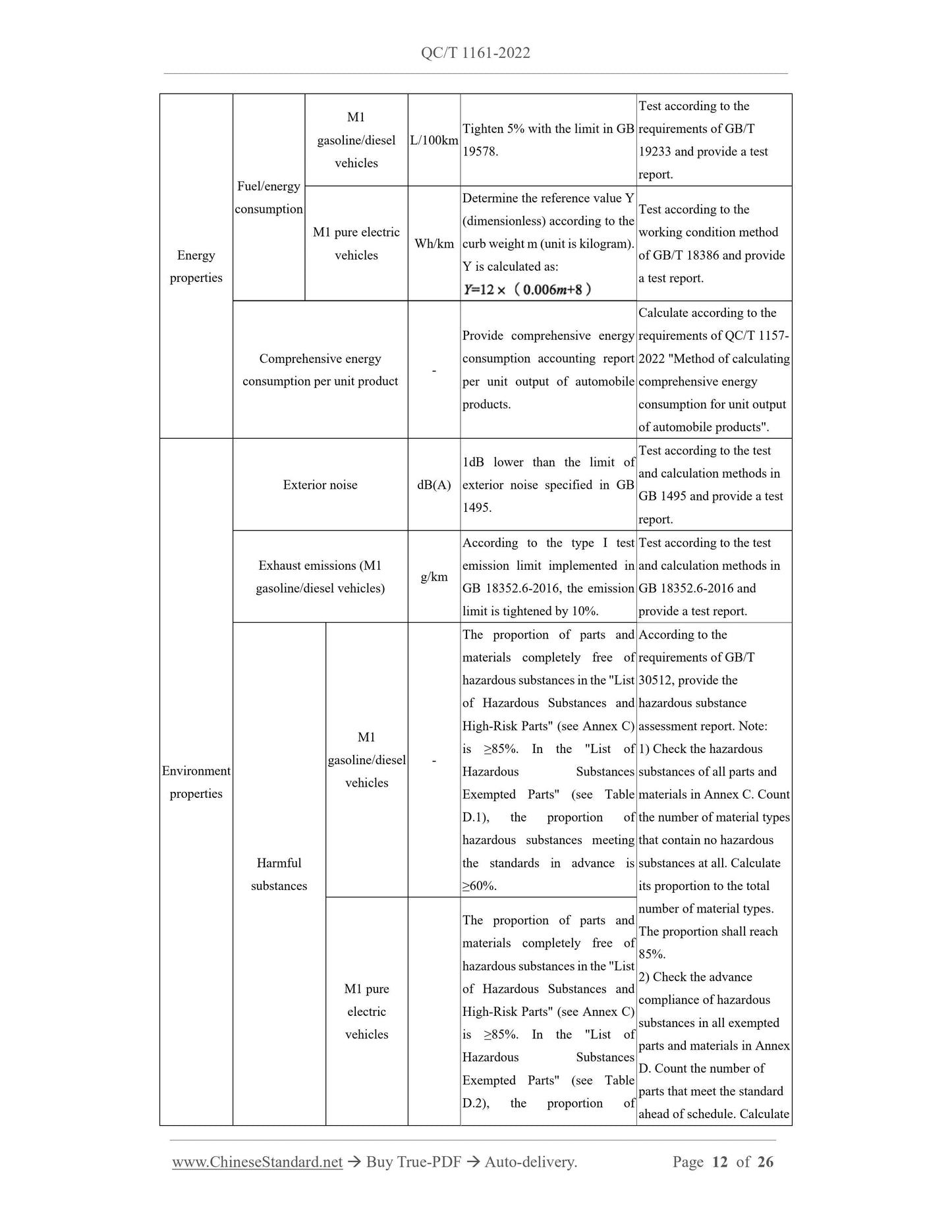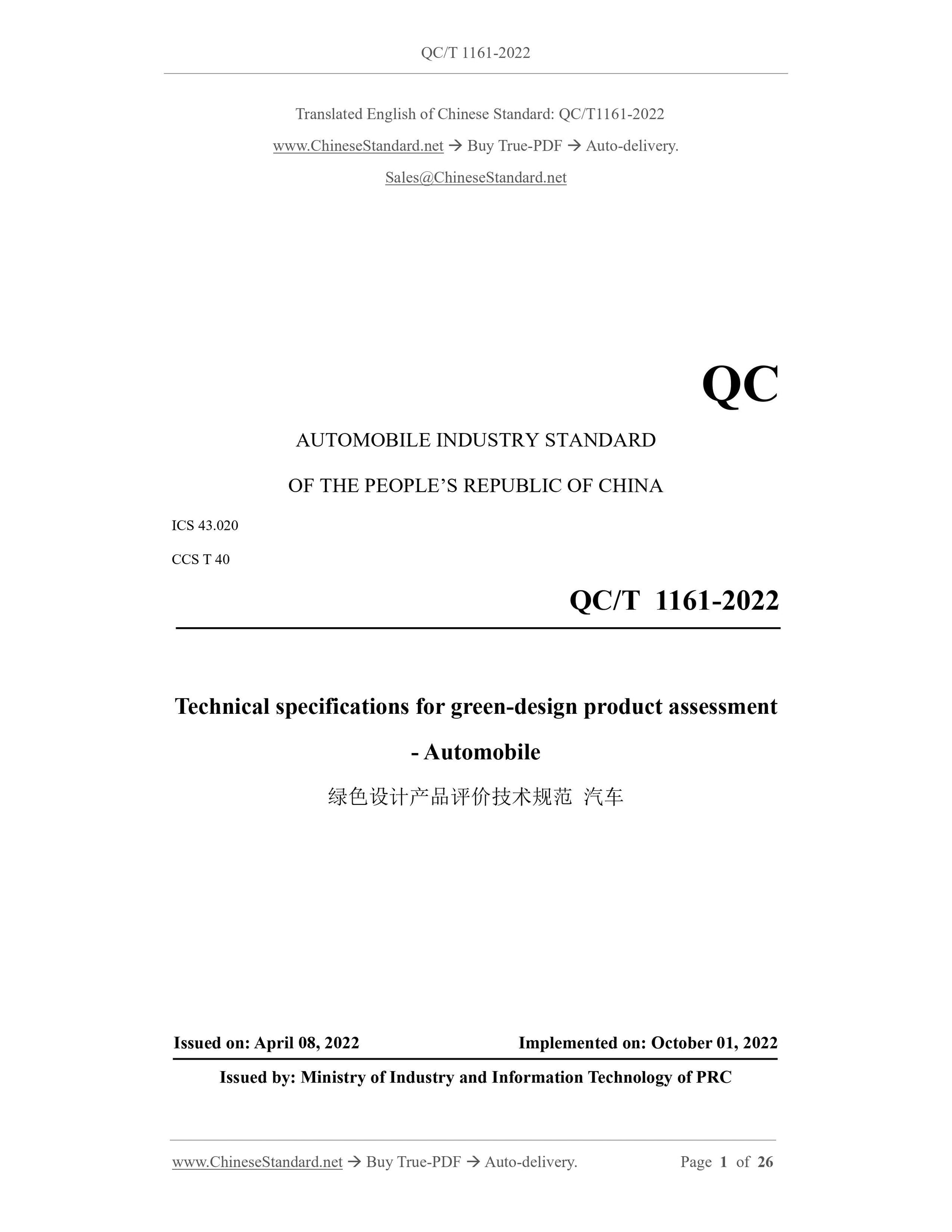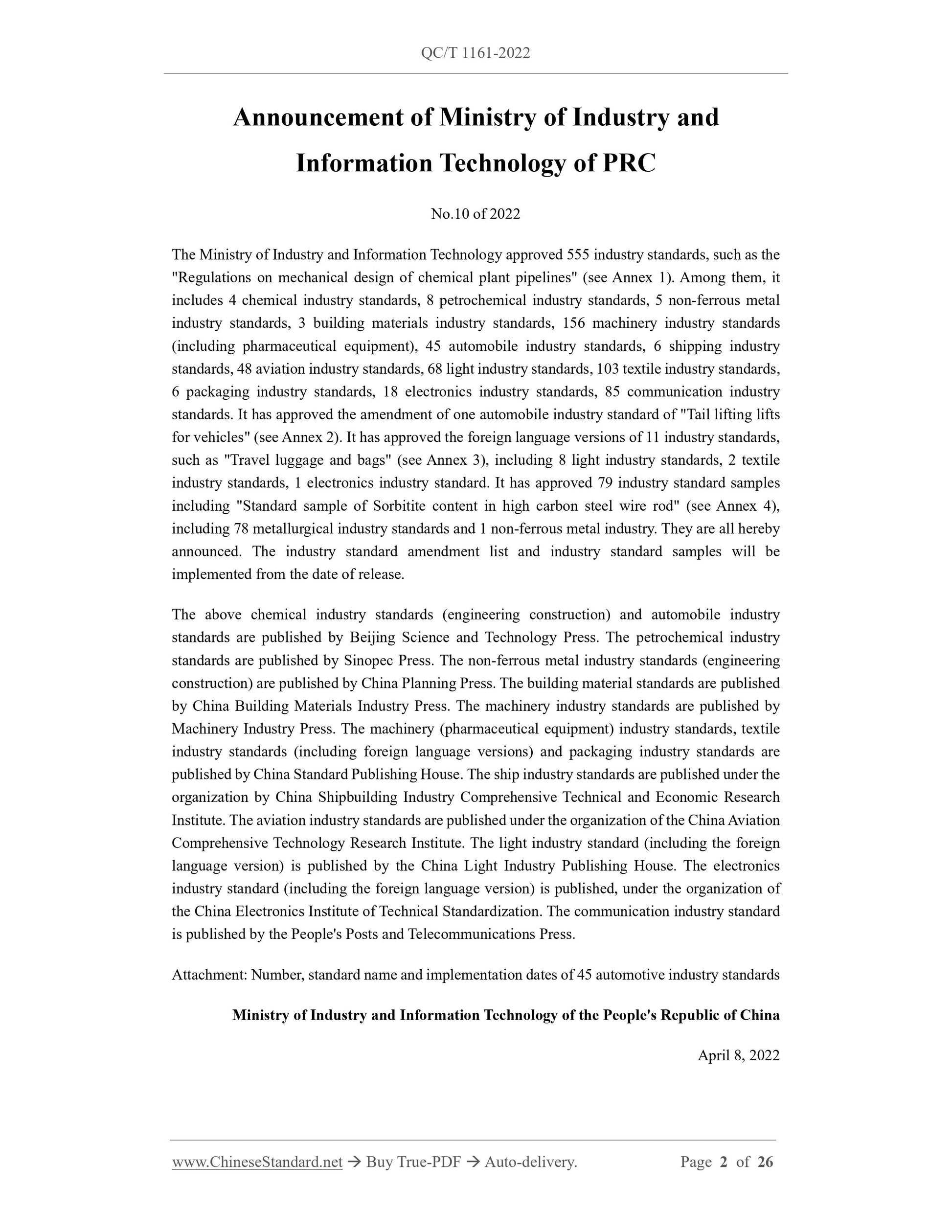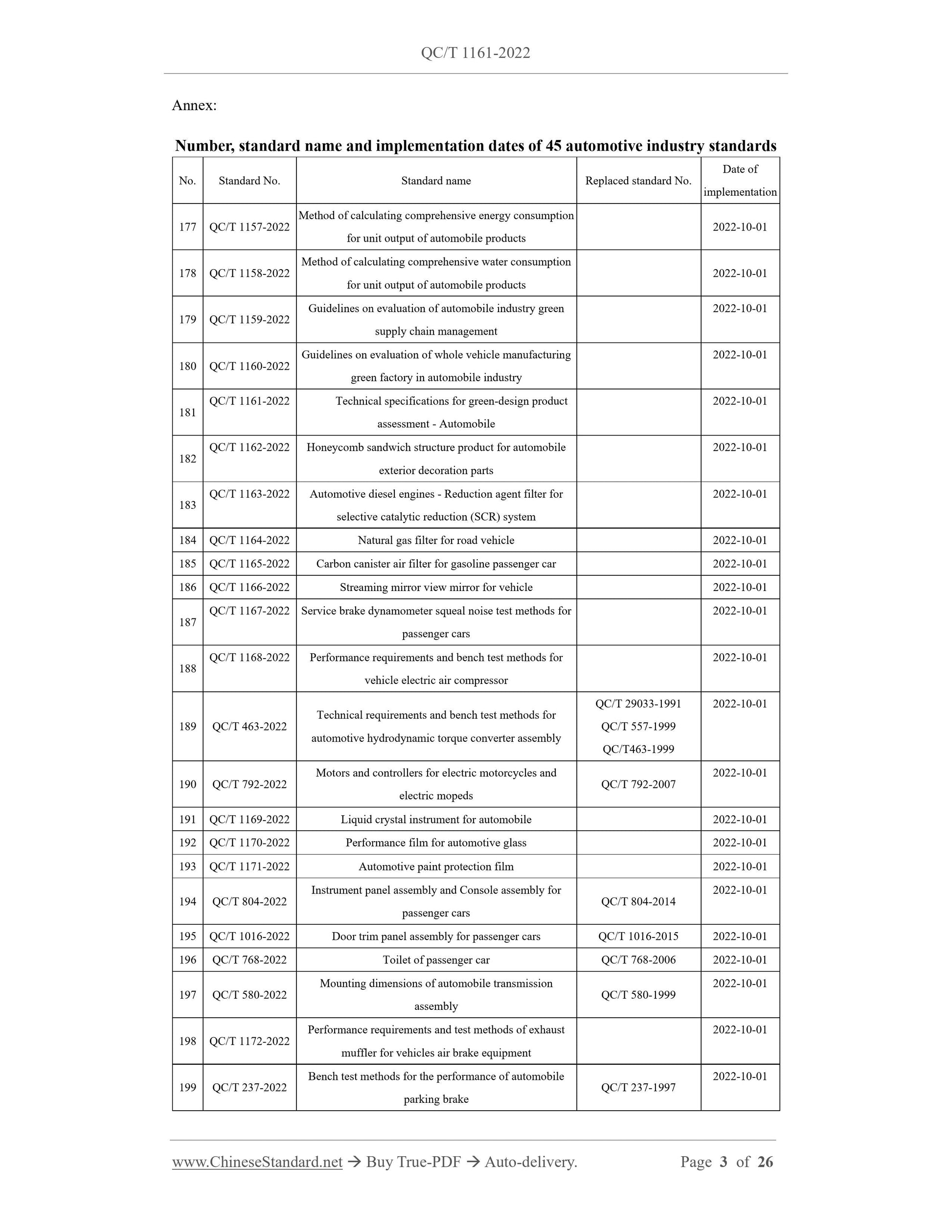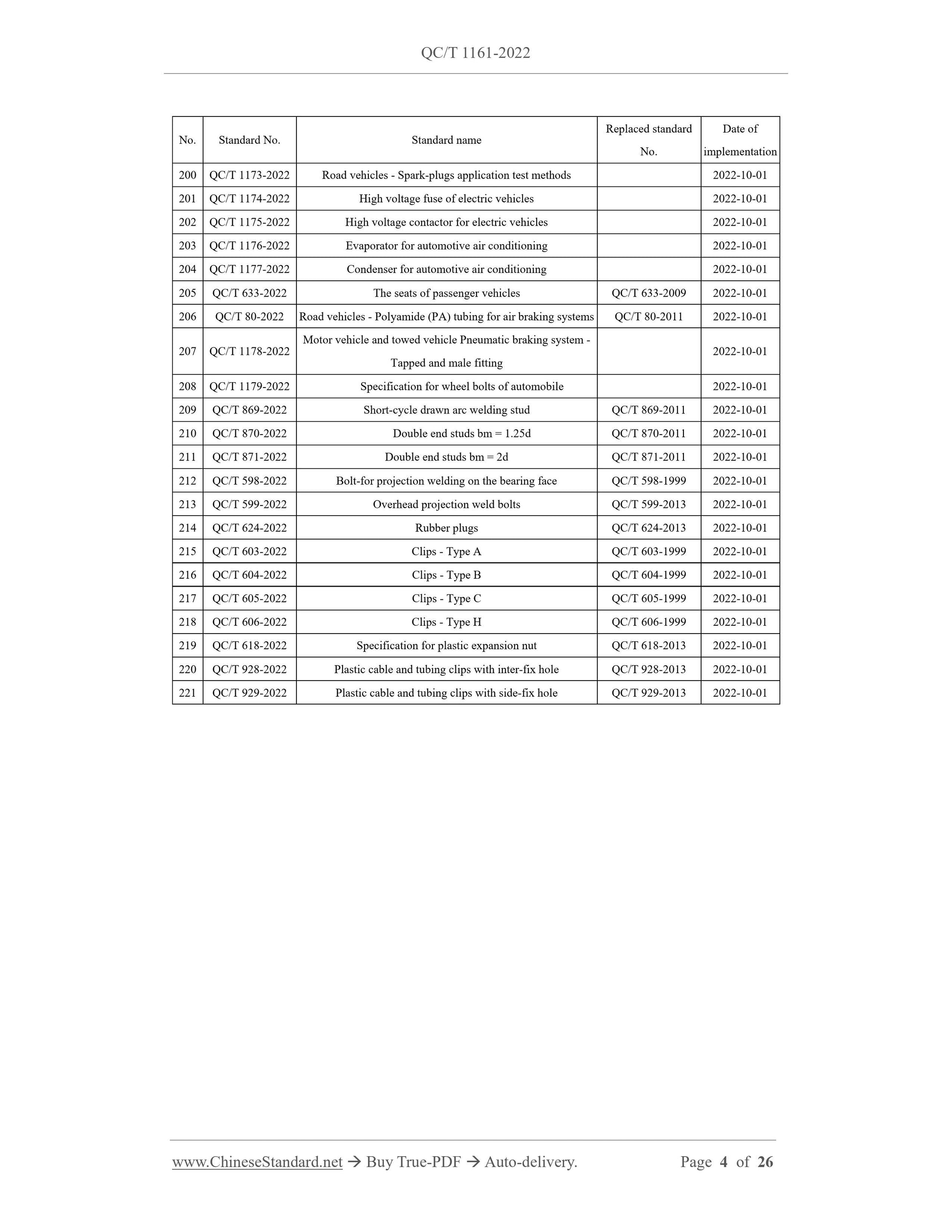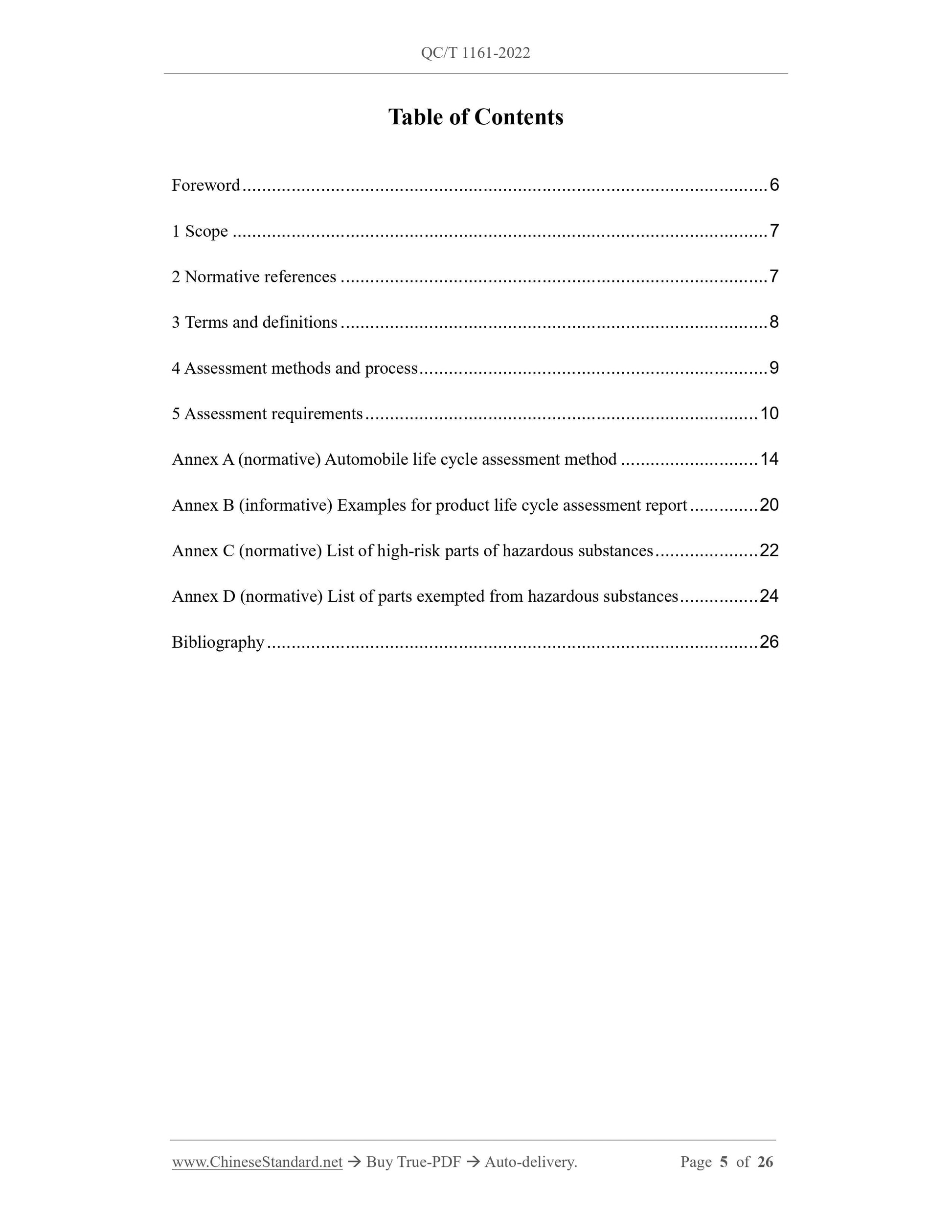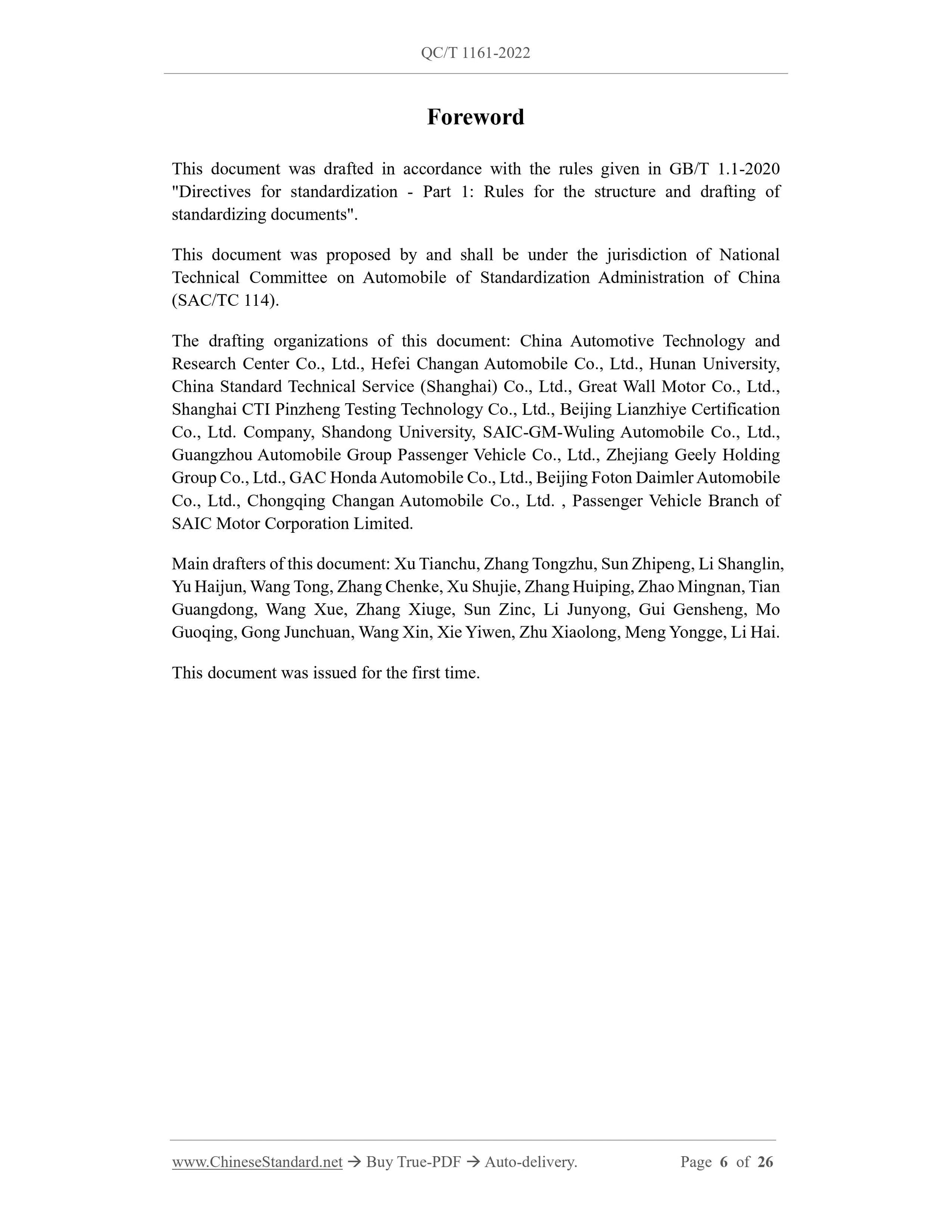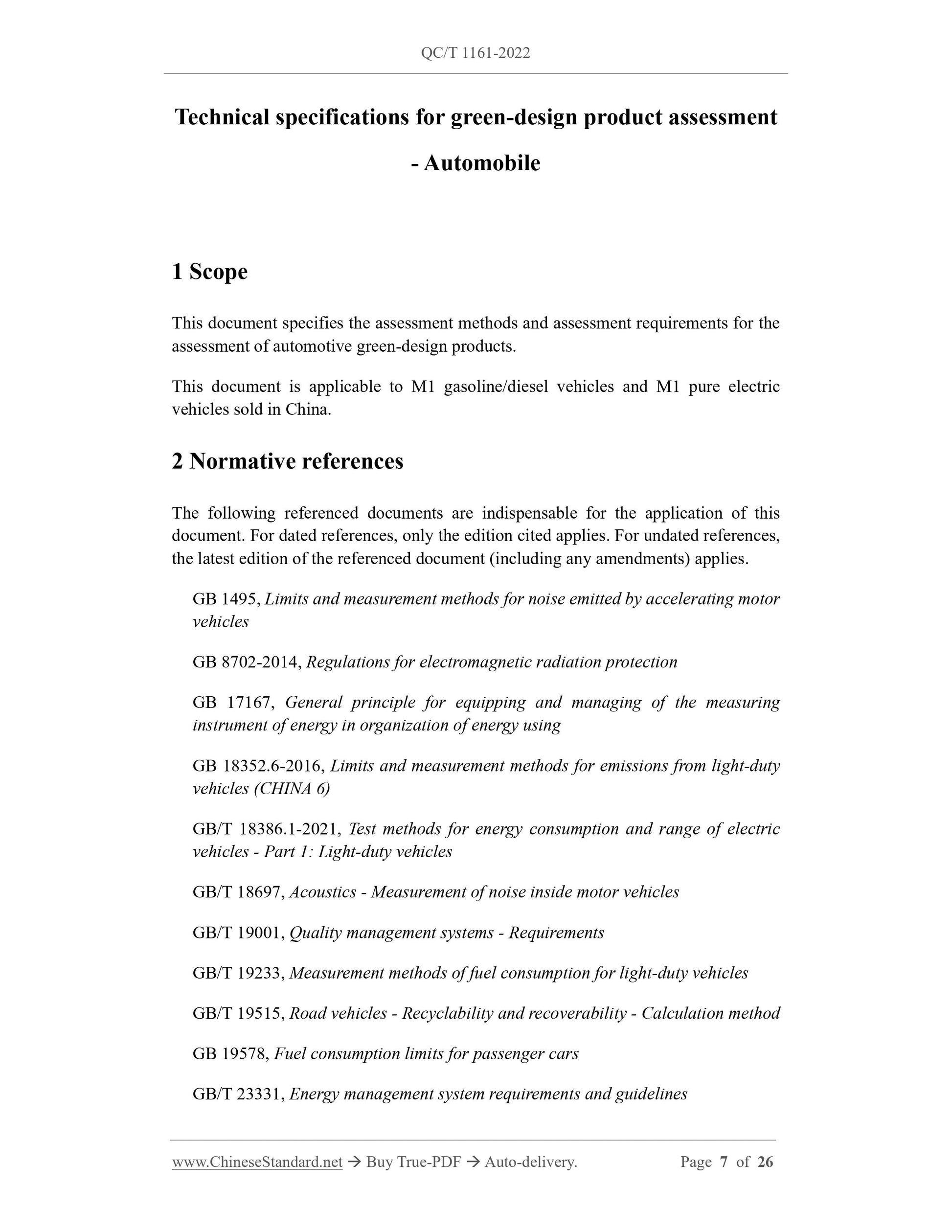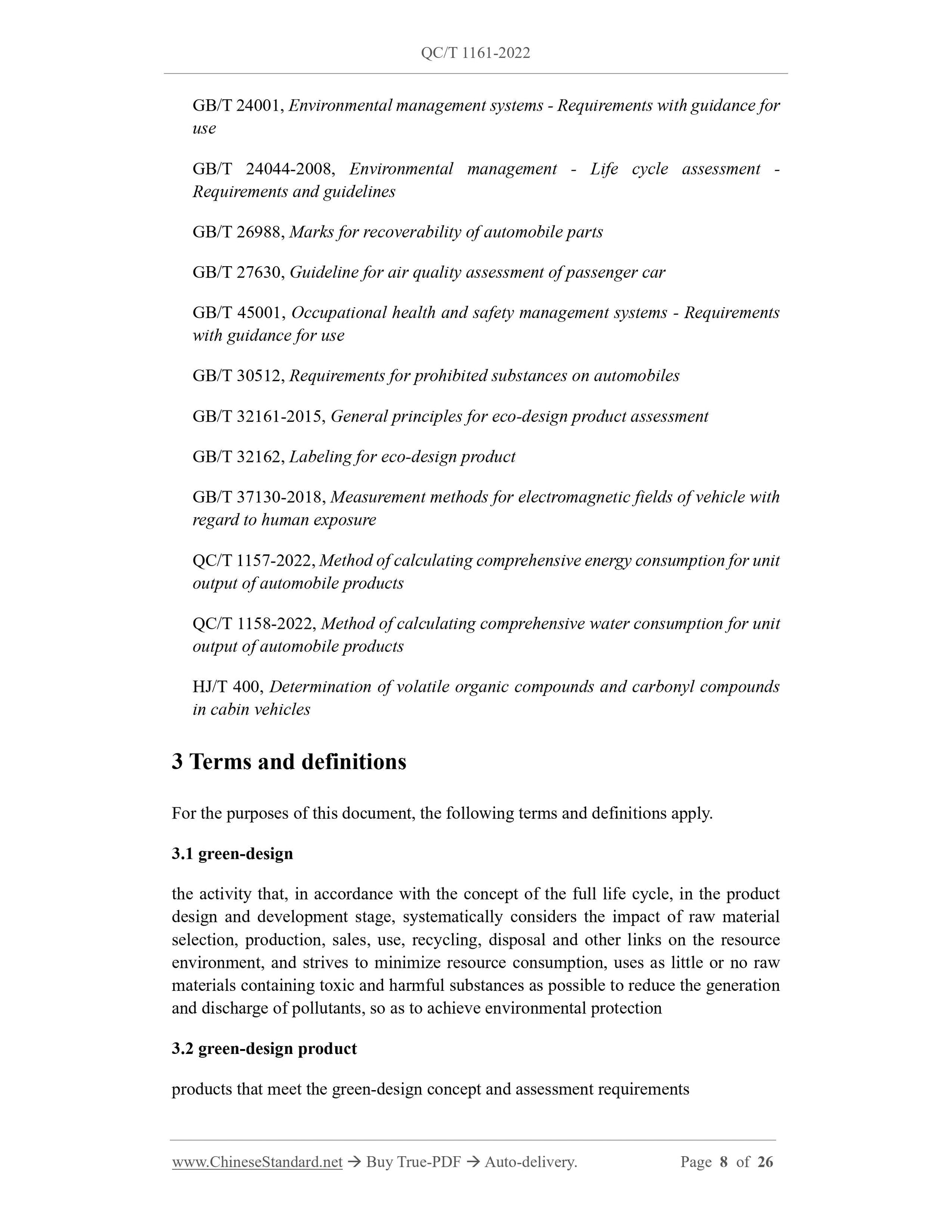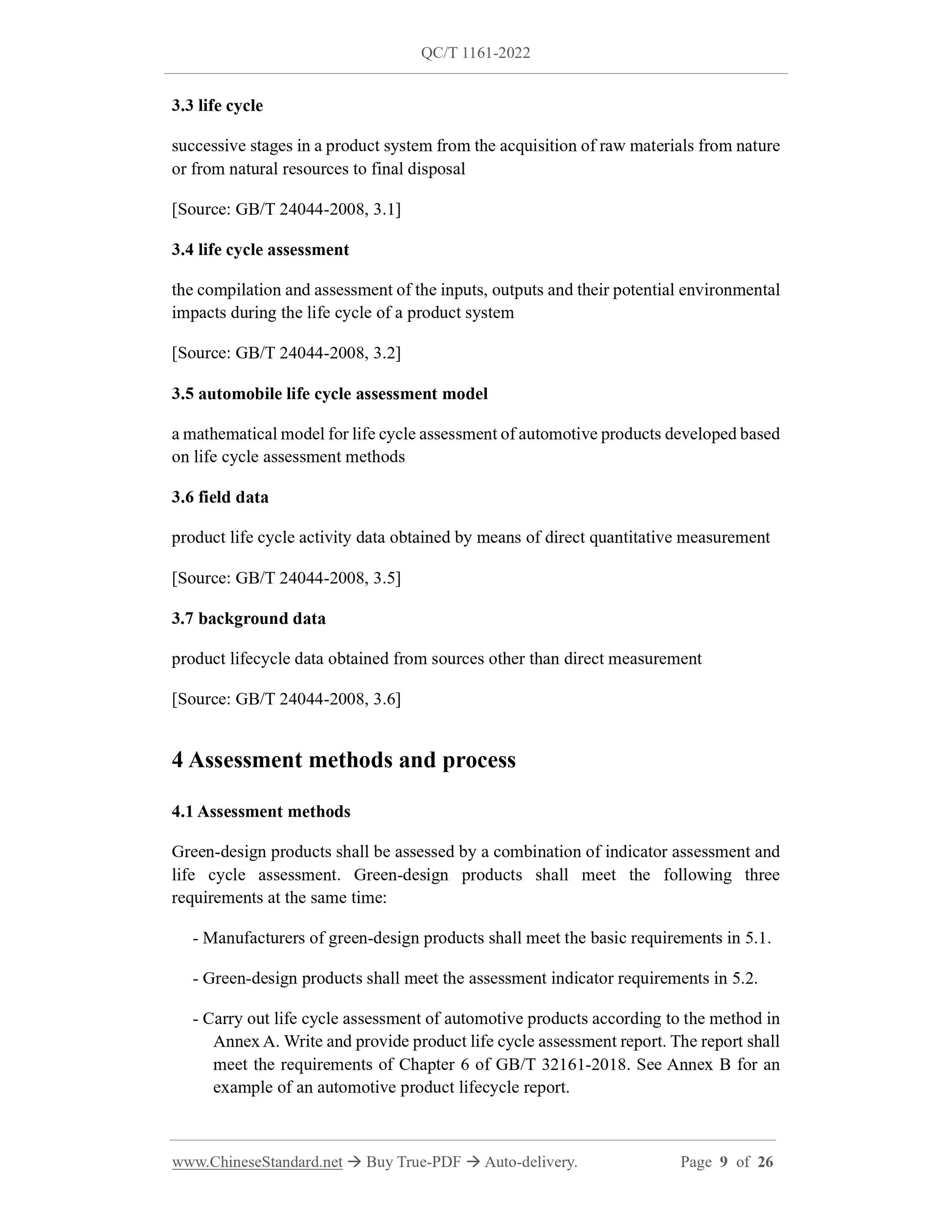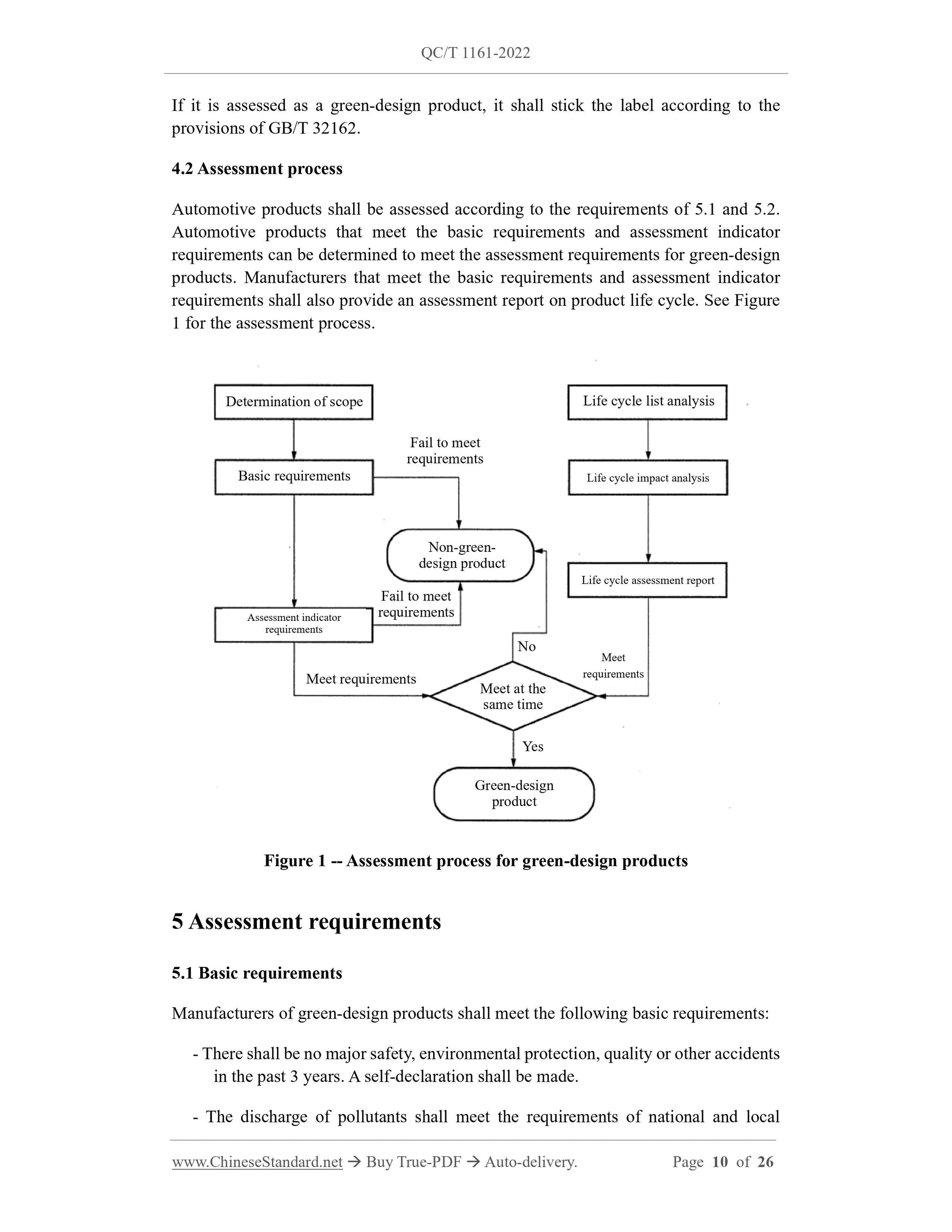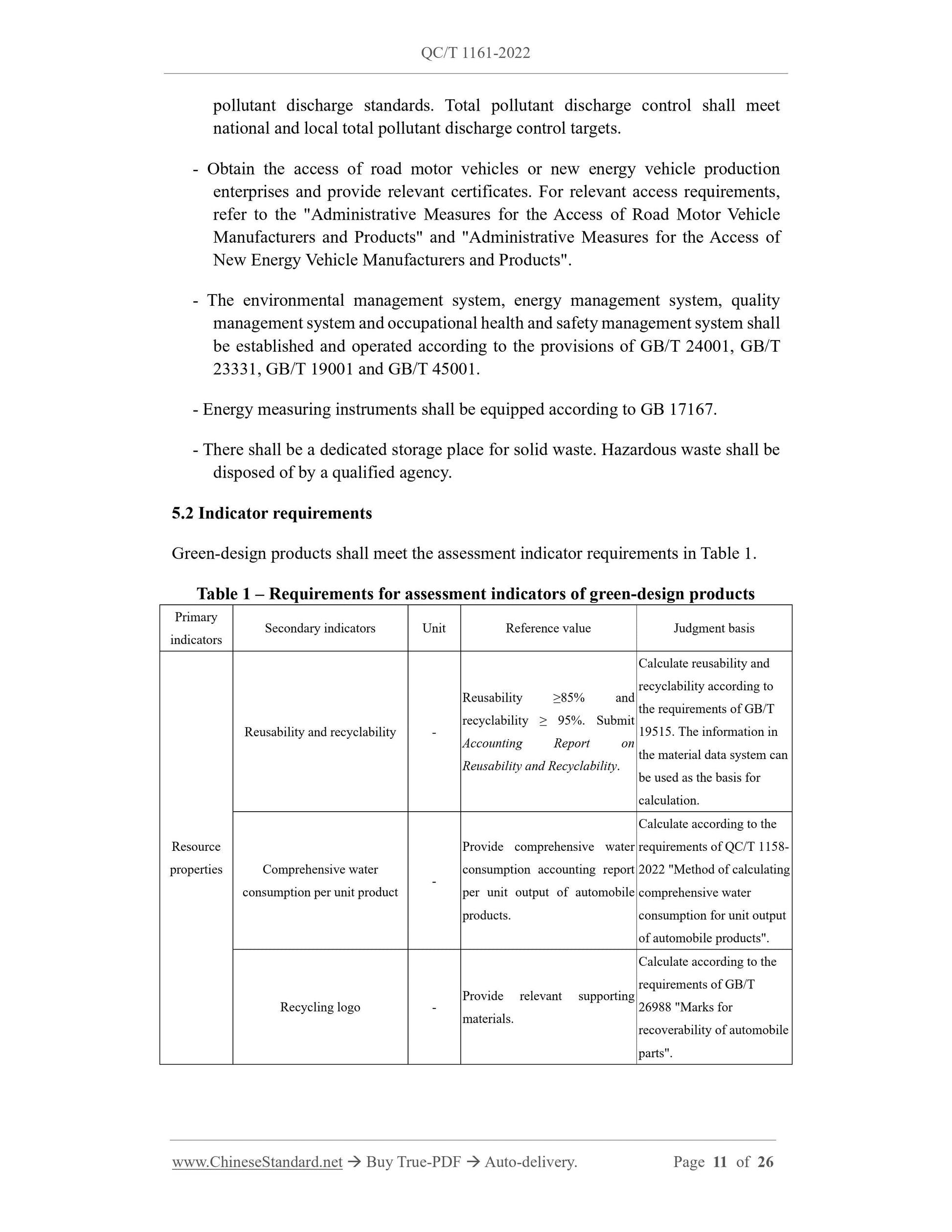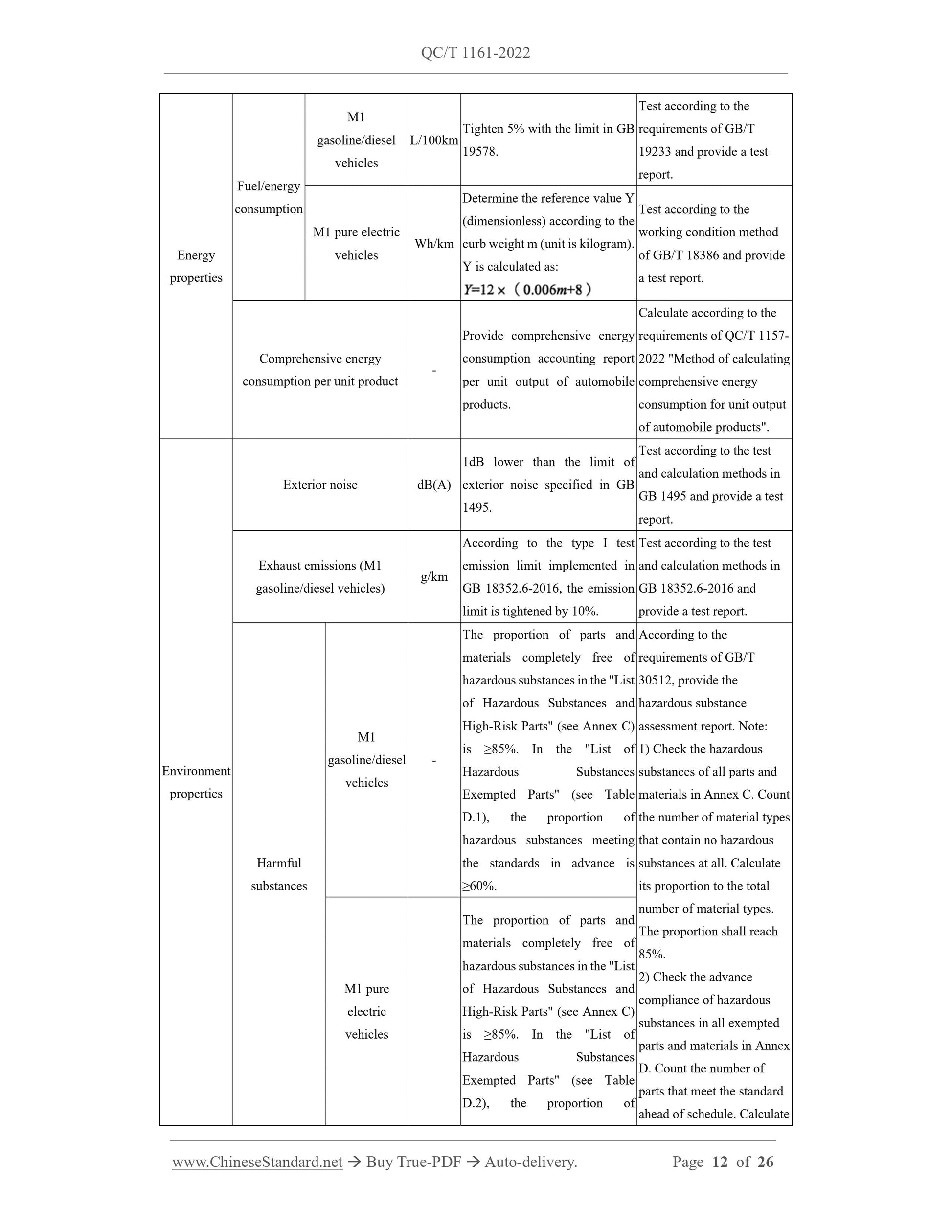1
/
of
12
PayPal, credit cards. Download editable-PDF & invoice in 1 second!
QC/T 1161-2022 English PDF (QCT1161-2022)
QC/T 1161-2022 English PDF (QCT1161-2022)
Regular price
$290.00 USD
Regular price
Sale price
$290.00 USD
Unit price
/
per
Shipping calculated at checkout.
Couldn't load pickup availability
Delivery: 3 seconds. Download true-PDF + Invoice.
Get QUOTATION in 1-minute: Click QC/T 1161-2022
Historical versions: QC/T 1161-2022
Preview True-PDF (Reload/Scroll if blank)
QC/T 1161-2022: Technical specifications for green-design product assessment - Automobile
QC/T 1161-2022
QC
AUTOMOBILE INDUSTRY STANDARD
OF THE PEOPLE’S REPUBLIC OF CHINA
ICS 43.020
CCS T 40
Technical specifications for green-design product assessment
- Automobile
ISSUED ON: APRIL 08, 2022
IMPLEMENTED ON: OCTOBER 01, 2022
Issued by: Ministry of Industry and Information Technology of PRC
Table of Contents
Foreword ... 8
1 Scope ... 9
2 Normative references ... 9
3 Terms and definitions ... 10
4 Assessment methods and process ... 11
5 Assessment requirements ... 12
Annex A (normative) Automobile life cycle assessment method ... 16
Annex B (informative) Examples for product life cycle assessment report ... 22
Annex C (normative) List of high-risk parts of hazardous substances ... 24
Annex D (normative) List of parts exempted from hazardous substances ... 26
Bibliography ... 28
Technical specifications for green-design product assessment
- Automobile
1 Scope
This document specifies the assessment methods and assessment requirements for the
assessment of automotive green-design products.
This document is applicable to M1 gasoline/diesel vehicles and M1 pure electric
vehicles sold in China.
2 Normative references
The following referenced documents are indispensable for the application of this
document. For dated references, only the edition cited applies. For undated references,
the latest edition of the referenced document (including any amendments) applies.
GB 1495, Limits and measurement methods for noise emitted by accelerating motor
vehicles
GB 8702-2014, Regulations for electromagnetic radiation protection
GB 17167, General principle for equipping and managing of the measuring
instrument of energy in organization of energy using
GB 18352.6-2016, Limits and measurement methods for emissions from light-duty
vehicles (CHINA 6)
GB/T 18386.1-2021, Test methods for energy consumption and range of electric
vehicles - Part 1: Light-duty vehicles
GB/T 18697, Acoustics - Measurement of noise inside motor vehicles
GB/T 19001, Quality management systems - Requirements
GB/T 19233, Measurement methods of fuel consumption for light-duty vehicles
GB/T 19515, Road vehicles - Recyclability and recoverability - Calculation method
GB 19578, Fuel consumption limits for passenger cars
GB/T 23331, Energy management system requirements and guidelines
GB/T 24001, Environmental management systems - Requirements with guidance for
use
GB/T 24044-2008, Environmental management - Life cycle assessment -
Requirements and guidelines
GB/T 26988, Marks for recoverability of automobile parts
GB/T 27630, Guideline for air quality assessment of passenger car
GB/T 45001, Occupational health and safety management systems - Requirements
with guidance for use
GB/T 30512, Requirements for prohibited substances on automobiles
GB/T 32161-2015, General principles for eco-design product assessment
GB/T 32162, Labeling for eco-design product
GB/T 37130-2018, Measurement methods for electromagnetic fields of vehicle with
regard to human exposure
QC/T 1157-2022, Method of calculating comprehensive energy consumption for unit
output of automobile products
QC/T 1158-2022, Method of calculating comprehensive water consumption for unit
output of automobile products
HJ/T 400, Determination of volatile organic compounds and carbonyl compounds
in cabin vehicles
3 Terms and definitions
For the purposes of this document, the following terms and definitions apply.
3.1 green-design
the activity that, in accordance with the concept of the full life cycle, in the product
design and development stage, systematically considers the impact of raw material
selection, production, sales, use, recycling, disposal and other links on the resource
environment, and strives to minimize resource consumption, uses as little or no raw
materials containing toxic and harmful substances as possible to reduce the generation
and discharge of pollutants, so as to achieve environmental protection
3.2 green-design product
products that meet the green-design concept and assessment requirements
3.3 life cycle
successive stages in a product system from the acquisition of raw materials from nature
or from natural resources to final disposal
[Source: GB/T 24044-2008, 3.1]
3.4 life cycle assessment
the compilation and assessment of the inputs, outputs and their potential environmental
impacts during the life cycle of a product system
[Source: GB/T 24044-2008, 3.2]
3.5 automobile life cycle assessment model
a mathematical model for life cycle assessment of automotive products developed based
on life cycle assessment methods
3.6 field data
product life cycle activity data obtained by means of direct quantitative measurement
[Source: GB/T 24044-2008, 3.5]
3.7 background data
product lifecycle data obtained from sources other than direct measurement
[Source: GB/T 24044-2008, 3.6]
4 Assessment methods and process
4.1 Assessment methods
Green-design products shall be assessed by a combination of indicator assessment and
life cycle assessment. Green-design products shall meet the following three
requirements at the same time:
- Manufacturers of green-design products shall meet the basic requirements in 5.1.
- Green-design products shall meet the assessment indicator requirements in 5.2.
- Carry out life cycle assessment of automotive products according to the method in
Annex A. Write and provide product life cycle assessment report. The report shall
meet the requirements of Chapter 6 of GB/T 32161-2018. See Annex B for an
example of an automotive product lifecycle report.
Annex A
(normative)
Automobile life cycle assessment method
A.1 Overview
Conduct vehicle life cycle assessment based on vehicle life cycle assessment standards,
methods or models. The process of life cycle assessment shall include determination of
purpose and scope, list analysis, impact assessment. The vehicle life cycle assessment
model can be used for assessment.
A.2 Purpose and scope determination
A.2.1 Purpose
By assessing the environmental impact of the life cycle, it provides support for the
improvement of automobile ecology and the improvement of the eco-friendliness of
automobiles.
A.2.2 Functional unit
Transportation service provided by driving 1 km during the lifetime of a vehicle. Life
cycle mileage is calculated as 1.5 km × 105 km.
A.2.3 System boundaries
This document includes the acquisition of raw materials, vehicle production, and use of
automobiles into the scope of accounting. It does not include carbon emissions from
infrastructure such as roads and workshops, equipment in various processes, personnel
in the factory area, and living facilities.
A.2.3.1 Raw material acquisition stage boundary
In the raw material acquisition stage, that is, the acquisition of resources and the
production stage of materials, the system boundary includes processes such as resource
extraction, processing and purification, and manufacturing. The following 22 material
categories for parts listed in Table A.1 of this document: steel, cast iron, aluminum alloy,
magnesium alloy, copper and copper alloy, PP, PA, PE, PVC, PU, glass, rubber, carbon
black, refrigerant, lead, sulfuric acid, ternary material, lithium iron phosphate, lithium
manganate, lithium cobaltate, graphite and lithium hexafluorophosphate. Other
homogeneous materials whose mass ratio is higher than 50% of the parts and which do
not bel...
Get QUOTATION in 1-minute: Click QC/T 1161-2022
Historical versions: QC/T 1161-2022
Preview True-PDF (Reload/Scroll if blank)
QC/T 1161-2022: Technical specifications for green-design product assessment - Automobile
QC/T 1161-2022
QC
AUTOMOBILE INDUSTRY STANDARD
OF THE PEOPLE’S REPUBLIC OF CHINA
ICS 43.020
CCS T 40
Technical specifications for green-design product assessment
- Automobile
ISSUED ON: APRIL 08, 2022
IMPLEMENTED ON: OCTOBER 01, 2022
Issued by: Ministry of Industry and Information Technology of PRC
Table of Contents
Foreword ... 8
1 Scope ... 9
2 Normative references ... 9
3 Terms and definitions ... 10
4 Assessment methods and process ... 11
5 Assessment requirements ... 12
Annex A (normative) Automobile life cycle assessment method ... 16
Annex B (informative) Examples for product life cycle assessment report ... 22
Annex C (normative) List of high-risk parts of hazardous substances ... 24
Annex D (normative) List of parts exempted from hazardous substances ... 26
Bibliography ... 28
Technical specifications for green-design product assessment
- Automobile
1 Scope
This document specifies the assessment methods and assessment requirements for the
assessment of automotive green-design products.
This document is applicable to M1 gasoline/diesel vehicles and M1 pure electric
vehicles sold in China.
2 Normative references
The following referenced documents are indispensable for the application of this
document. For dated references, only the edition cited applies. For undated references,
the latest edition of the referenced document (including any amendments) applies.
GB 1495, Limits and measurement methods for noise emitted by accelerating motor
vehicles
GB 8702-2014, Regulations for electromagnetic radiation protection
GB 17167, General principle for equipping and managing of the measuring
instrument of energy in organization of energy using
GB 18352.6-2016, Limits and measurement methods for emissions from light-duty
vehicles (CHINA 6)
GB/T 18386.1-2021, Test methods for energy consumption and range of electric
vehicles - Part 1: Light-duty vehicles
GB/T 18697, Acoustics - Measurement of noise inside motor vehicles
GB/T 19001, Quality management systems - Requirements
GB/T 19233, Measurement methods of fuel consumption for light-duty vehicles
GB/T 19515, Road vehicles - Recyclability and recoverability - Calculation method
GB 19578, Fuel consumption limits for passenger cars
GB/T 23331, Energy management system requirements and guidelines
GB/T 24001, Environmental management systems - Requirements with guidance for
use
GB/T 24044-2008, Environmental management - Life cycle assessment -
Requirements and guidelines
GB/T 26988, Marks for recoverability of automobile parts
GB/T 27630, Guideline for air quality assessment of passenger car
GB/T 45001, Occupational health and safety management systems - Requirements
with guidance for use
GB/T 30512, Requirements for prohibited substances on automobiles
GB/T 32161-2015, General principles for eco-design product assessment
GB/T 32162, Labeling for eco-design product
GB/T 37130-2018, Measurement methods for electromagnetic fields of vehicle with
regard to human exposure
QC/T 1157-2022, Method of calculating comprehensive energy consumption for unit
output of automobile products
QC/T 1158-2022, Method of calculating comprehensive water consumption for unit
output of automobile products
HJ/T 400, Determination of volatile organic compounds and carbonyl compounds
in cabin vehicles
3 Terms and definitions
For the purposes of this document, the following terms and definitions apply.
3.1 green-design
the activity that, in accordance with the concept of the full life cycle, in the product
design and development stage, systematically considers the impact of raw material
selection, production, sales, use, recycling, disposal and other links on the resource
environment, and strives to minimize resource consumption, uses as little or no raw
materials containing toxic and harmful substances as possible to reduce the generation
and discharge of pollutants, so as to achieve environmental protection
3.2 green-design product
products that meet the green-design concept and assessment requirements
3.3 life cycle
successive stages in a product system from the acquisition of raw materials from nature
or from natural resources to final disposal
[Source: GB/T 24044-2008, 3.1]
3.4 life cycle assessment
the compilation and assessment of the inputs, outputs and their potential environmental
impacts during the life cycle of a product system
[Source: GB/T 24044-2008, 3.2]
3.5 automobile life cycle assessment model
a mathematical model for life cycle assessment of automotive products developed based
on life cycle assessment methods
3.6 field data
product life cycle activity data obtained by means of direct quantitative measurement
[Source: GB/T 24044-2008, 3.5]
3.7 background data
product lifecycle data obtained from sources other than direct measurement
[Source: GB/T 24044-2008, 3.6]
4 Assessment methods and process
4.1 Assessment methods
Green-design products shall be assessed by a combination of indicator assessment and
life cycle assessment. Green-design products shall meet the following three
requirements at the same time:
- Manufacturers of green-design products shall meet the basic requirements in 5.1.
- Green-design products shall meet the assessment indicator requirements in 5.2.
- Carry out life cycle assessment of automotive products according to the method in
Annex A. Write and provide product life cycle assessment report. The report shall
meet the requirements of Chapter 6 of GB/T 32161-2018. See Annex B for an
example of an automotive product lifecycle report.
Annex A
(normative)
Automobile life cycle assessment method
A.1 Overview
Conduct vehicle life cycle assessment based on vehicle life cycle assessment standards,
methods or models. The process of life cycle assessment shall include determination of
purpose and scope, list analysis, impact assessment. The vehicle life cycle assessment
model can be used for assessment.
A.2 Purpose and scope determination
A.2.1 Purpose
By assessing the environmental impact of the life cycle, it provides support for the
improvement of automobile ecology and the improvement of the eco-friendliness of
automobiles.
A.2.2 Functional unit
Transportation service provided by driving 1 km during the lifetime of a vehicle. Life
cycle mileage is calculated as 1.5 km × 105 km.
A.2.3 System boundaries
This document includes the acquisition of raw materials, vehicle production, and use of
automobiles into the scope of accounting. It does not include carbon emissions from
infrastructure such as roads and workshops, equipment in various processes, personnel
in the factory area, and living facilities.
A.2.3.1 Raw material acquisition stage boundary
In the raw material acquisition stage, that is, the acquisition of resources and the
production stage of materials, the system boundary includes processes such as resource
extraction, processing and purification, and manufacturing. The following 22 material
categories for parts listed in Table A.1 of this document: steel, cast iron, aluminum alloy,
magnesium alloy, copper and copper alloy, PP, PA, PE, PVC, PU, glass, rubber, carbon
black, refrigerant, lead, sulfuric acid, ternary material, lithium iron phosphate, lithium
manganate, lithium cobaltate, graphite and lithium hexafluorophosphate. Other
homogeneous materials whose mass ratio is higher than 50% of the parts and which do
not bel...
Share
